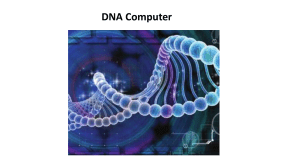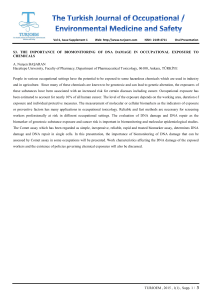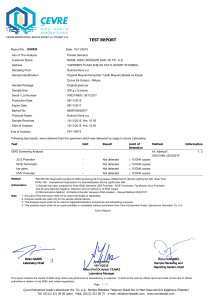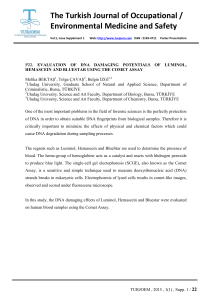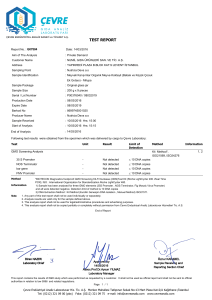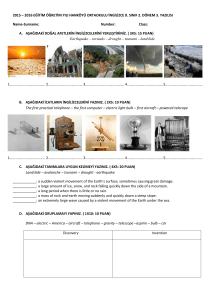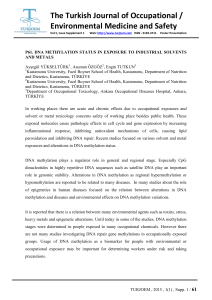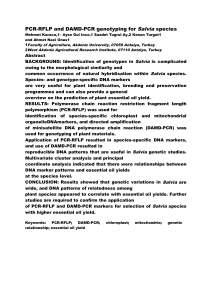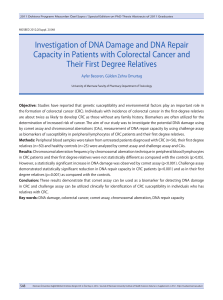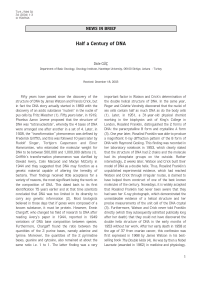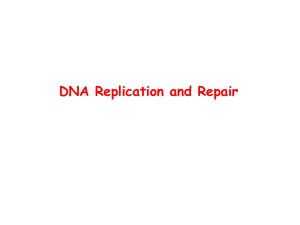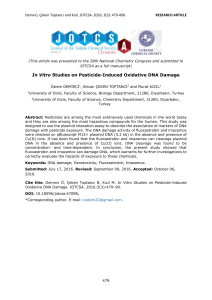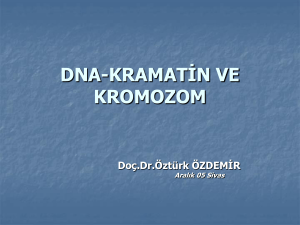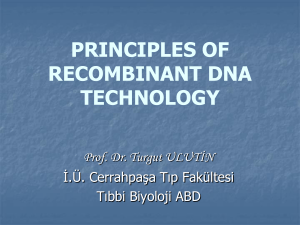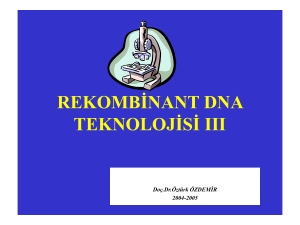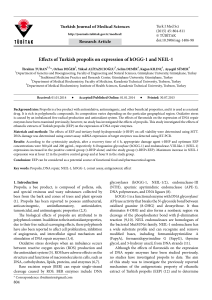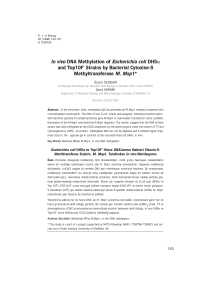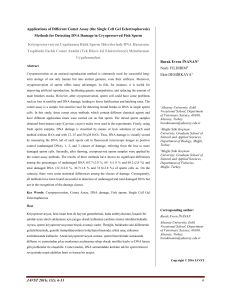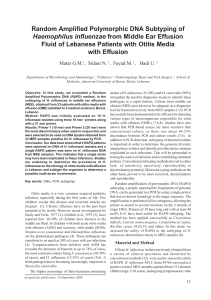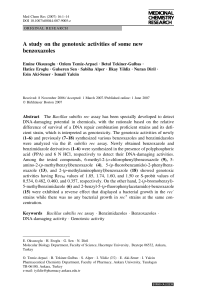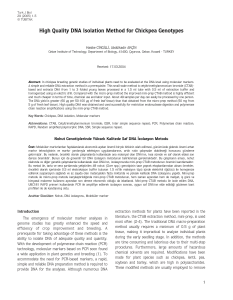DNA Cleavage Activity of Diazonium Salts
advertisement
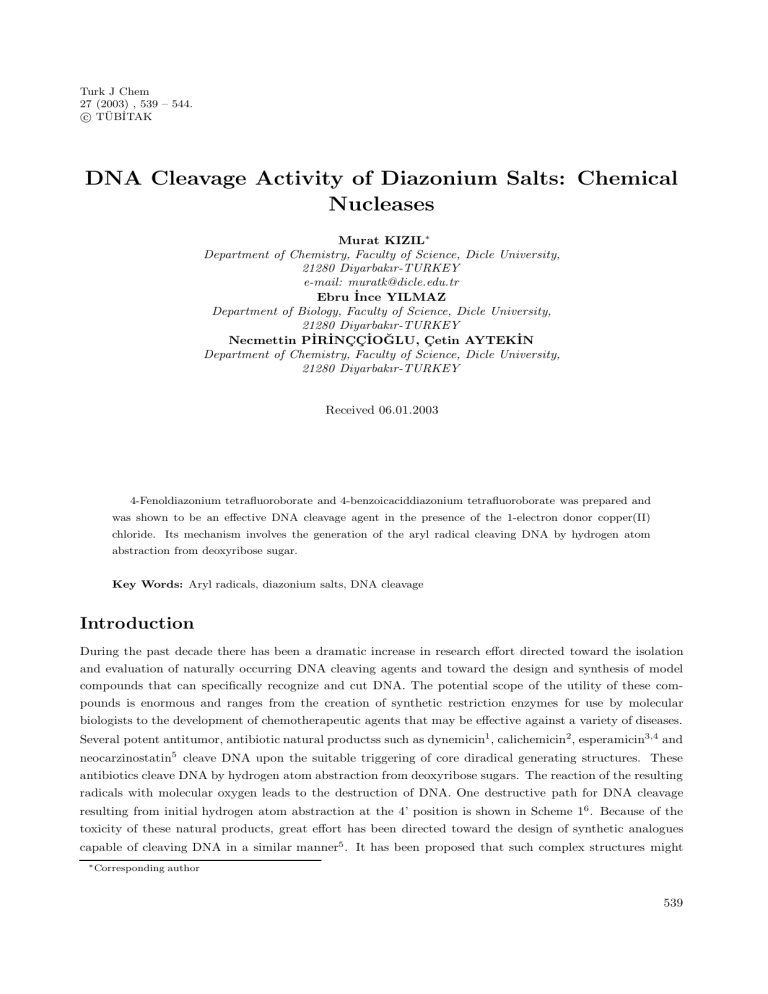
Turk J Chem 27 (2003) , 539 – 544. c TÜBİTAK DNA Cleavage Activity of Diazonium Salts: Chemical Nucleases Murat KIZIL∗ Department of Chemistry, Faculty of Science, Dicle University, 21280 Diyarbakır-TURKEY e-mail: [email protected] Ebru İnce YILMAZ Department of Biology, Faculty of Science, Dicle University, 21280 Diyarbakır-TURKEY Necmettin PİRİNÇÇİOĞLU, Çetin AYTEKİN Department of Chemistry, Faculty of Science, Dicle University, 21280 Diyarbakır-TURKEY Received 06.01.2003 4-Fenoldiazonium tetrafluoroborate and 4-benzoicaciddiazonium tetrafluoroborate was prepared and was shown to be an effective DNA cleavage agent in the presence of the 1-electron donor copper(II) chloride. Its mechanism involves the generation of the aryl radical cleaving DNA by hydrogen atom abstraction from deoxyribose sugar. Key Words: Aryl radicals, diazonium salts, DNA cleavage Introduction During the past decade there has been a dramatic increase in research effort directed toward the isolation and evaluation of naturally occurring DNA cleaving agents and toward the design and synthesis of model compounds that can specifically recognize and cut DNA. The potential scope of the utility of these compounds is enormous and ranges from the creation of synthetic restriction enzymes for use by molecular biologists to the development of chemotherapeutic agents that may be effective against a variety of diseases. Several potent antitumor, antibiotic natural productss such as dynemicin1 , calichemicin2 , esperamicin3,4 and neocarzinostatin5 cleave DNA upon the suitable triggering of core diradical generating structures. These antibiotics cleave DNA by hydrogen atom abstraction from deoxyribose sugars. The reaction of the resulting radicals with molecular oxygen leads to the destruction of DNA. One destructive path for DNA cleavage resulting from initial hydrogen atom abstraction at the 4’ position is shown in Scheme 16 . Because of the toxicity of these natural products, great effort has been directed toward the design of synthetic analogues capable of cleaving DNA in a similar manner5 . It has been proposed that such complex structures might ∗ Corresponding author 539 DNA Cleavage Activity of Diazonium Salts: Chemical Nucleases, M. KIZIL, et al., not be needed, instead an aryl7 or vinyl8 radical would be capable of causing the hydrogen atom abstraction reaction from deoxyribose, which initiates the scission of DNA. It was determined in previous study7 that benzenediazonium tetrafluoroborate was able to cleave DNA. The chosen candidate was benzenediazonium tetrafluoroborate due to its water solubility and the fact that the positively charged diazonium moiety should be attracted to the negatively charged phosphates on the periphery of the DNA duplex. H 5' O PO H' O PO Base H' Base • 1 4 OP OP O2 PO O Base O PO HOO rearrangement HO Criegee O Base OP OP H PO OH O + O Base Scheme 1. DNA cleavage via C4’ Criegee rearrangement6 . The main purposes of this study were to (1) synthesize and evaluate 2 aryl substituted analogues of a benzenediazonium tetrafluoroborate, (2) to the effect of aryl substitution on radical reactivity and, ultimately, DNA cleavage ability. The reaction of the p-diazonium anilide of 5-carboxyspermine with pBR322 plasmid DNA has been conducted9 , and DNA cleavage was observed in daylight via a hydrolytic pathway. It was suggested that the DNA cleavage mechanism is photochemical and probably hydrolytic. In the reaction light is necessary. Aqueous solutions of arenediazonium salts are known to be converted on illumination into aryl cations, which are capable of behaving as alkylating agents. The alkylation of purine bases on DNA is used to trigger DNA cleavage. The reaction of single nucleosides and nucleotides with diazonium salts has been investigated10,11. Those papers dealt with the formation of triazenes with adenine and the azo compound with guanine. In the present study, the ability of 4-fenoldiazonium tetrafluoroborate and 4benzoicaciddiazonium tetrafluoroborate to facilitate DNA cleavage was examined using supercoiled plasmid DNA pBluescript M13+ by agarose gel electrophoresis. Experimental Apparatus Melting points were determined on a Kofler hot stage apparatus and are uncorrected. Infrared spectra were obtained on a Perkin-Elmer 1600 series FTIR. 1 H NMR spectra were recorded at 250 MHz on a Bruker WM 250. 540 DNA Cleavage Activity of Diazonium Salts: Chemical Nucleases, M. KIZIL, et al., Purification of Plasmid DNA The plasmid DNA pBluescript M13+ was prepared and isolated according to standard protocols using a Qiagene plasmid mini preparation kit (Qiagene)12 . The purity of pBluescript M13+ was confirmed via both agarose gel electrophoresis and UV spectroscopy by determining the ratio of absorbance at 260 nm to the absorbance at 280 nm13. The concentration of DNA was determined from the absorbance at 260 nm (A260 = 1.0 for 50 µg/mL). Synthesis of Diazonium Salts The desired benzenediazonium tetrafluoroborate (1a), 4-fenoldiazonium tetrafluoroborate (1b) and 4-benzoicaciddiazonium tetrafluoroborate (1c) were prepared using standard procedures14 (Scheme 2). The diazonium salt 1a was obtained as brown crystals, 1b as fine yellow crystals and 1c as light brown crystals. R R _ H 2N + BF 4N2 1 a) R = H b) R = OH c) R = CO2 H Scheme 2. Synthesis of diazonium salts (1a-c). Reagents and Conditions: isoamyl nitrite, HBF4 (aq.), EtOH, 0 ◦ C, 30 min. Synthesis of benzenediazonium tetrafluoroborate (1a). Anilin (0.4 g, 4.29 mmol) was dissolved in ethanol (1 mL) and aqueous fluoroboric acid (48% solution; 0.95 mL, 12.88 mmol) was added to the solution; the mixture was then cooled to –5 ◦ C. Isoamyl nitrite (0.69 mL, 0.60 g, 5.15 mmol) was added dropwise to the mixture and stirring continued for 0.5 h. Dilution of the mixture with diethyl ether (30 mL) led to the precipitation of benzenediazonium tetrafluoroborate 1a as brown crystals. The purification of benzenediazonium tetrafluoroborate was achieved by dissolving in cold acetone and then precipitating by the addition of cold diethyl ether (0.30 g, 1.57 mmol, 75%). mp 93-95 ◦ C (decomp.) νmax (KBr)/cm−1 2594, 2365, 2285, 1563, 1493, 1030, 740; 1 H NMR (250Mz, CD3 COCD3 ) δ 8.85 (d, J = 7.5 Hz, 2H), 8.40 (t, J = 7.5 Hz, 1H), 8.10 (t, J = 7.5 Hz, 2H). Synthesis of 4-fenoldiazonium tetrafluoroborate (1b). 4-aminophenol (0.4 g, 3.66 mmol) was dissolved in ethanol (1m L) and aqueous fluoroboric acid (48% solution; 0.53 mL, 10.99 mmol) was added to the solution; the mixture was then cooled to -5 ◦ C. Isoamyl nitrite (0.59 mL, 0.51 g, 4.39 mmol) was added dropwise to the mixture and stirring continued for 0.5 h. Dilution of the mixture with diethyl ether (30 mL) led to the precipitation of 4-fenoldiazonium tetrafluoroborate 1b as fine yellow crystals. The purification of 4-fenoldiazonium tetrafluoroborate was achieved by dissolving in cold acetone and then precipitating by the addition of cold diethyl ether (0.32 g, 1.54 mmol, 81%). mp 122-124 ◦ C (decomp.) νmax (KBr)/cm−1 3344, 2912, 2245, 1600, 1576, 1467, 1311, 1070, 840, 516; 1 H NMR (400Mz, D2 O) δ 8.48 (d, J = 9.3 Hz, 2H), 7.33 (d, J = 9.3 Hz, 2H). 541 DNA Cleavage Activity of Diazonium Salts: Chemical Nucleases, M. KIZIL, et al., Synthesis of 4-benzoicaciddiazonium tetrafluoroborate (1c). 4-aminobenzoic acid (0.4 g, 2.91 mmol) was dissolved in ethanol (1 mL) and aqueous fluoroboric acid solution (48% solution; 0.65 mL, 8.75 mmol) was added to the solution; the mixture was then cooled to –5 ◦ C. Isoamyl nitrite (0.46 mL, 0.40 g, 3.50 mmol) was added dropwise to the mixture and stirring continued for 0.5 h. Dilution of the mixture with diethyl ether (30 mL) led to the precipitation of 4-benzoicaciddiazonium tetrafluoroborate 1c as light brown crystals. The purification of 4-benzoicaciddiazonium tetrafluoroborate was achieved by dissolving in cold acetone and then precipitating by the addition of cold diethyl ether (0.31 g, 1.31 mmol, 78%). mp 103-104 ◦ C (decomp.) νmax (KBr)/cm−1 3488, 3085, 3065, 2930, 2285, 1723, 1402, 1363, 1207, 1057, 807, 699; 1 H NMR (400Mz, D2 O) δ 8.42 (d, J = 8.8 Hz, 2H), 8. 18 (d, J = 8.8 Hz, 2H). Cleavage of pBluescript M13+ DNA by exposure to diazonium salts with inorganic 1 electron donor The following reactions were carried out in 0.5 mL Eppendorf tubes protected from light by means of a foil covering and used within the confines of a dark room. The reactions were all performed at room temperature in water. We took advantage of the fact that double-stranded plasmid DNA molecules generally exhibited 3 conformations that reflected the integrity of the DNA: Form I, supercoiled (no breaks); Form II, open circular (a single break on one of the DNA strands); Form III, linear (one or more breaks on both strands). All the tubes contained 600 ng pBluescript M13+ DNA, comprised of the supercoiled duplex (Form I), the open circular, (Form II), and the linear form (Form III). The reaction mixture were composed of pBluescript M13+ DNA, 3.1 mM copper (II) chloride and 1.5 mM benzenediazonium tetrafluoroborate (1a) or 1.5 mM 4-fenoldiazonium tetrafluoroborate (1b) or 1.5 mM 4-benzoicaciddiazonium tetrafluoroborate (1c). Controls including pBluescript M13+ DNA + copper (II) chloride (3.1 mM), and pBluescript M13+ DNA + diazonium salt (1.5 mM) were also run, besides each cleavage reaction. After 1 h of incubation, 3 µL of 50% glycerol loading buffer13 (containing 0.1% bromo phenol blue, 150 mM EDTA, 1% SDS in 2 M Tris, 1 M acetate, pH 8) was added to each sample before being loaded (still in the dark) into the 1% agarose gel containing an aqueous ethidium bromide solution (10 mg/mL). The gel was electrophoresed for approximately 1 h at 80 V in 1 × TBE (40 mM Tris, 20 mM borate, 1 mM EDTA pH 8) buffer. DNA in gel was visualized by UV-transillumination and the gel photographed using Polaroid 667 film. In the cleavage experiment, copper (II) chloride was used as inorganic 1 electron donor in order to reduce the diazonium salts to the aromatic radical. This resulted in lanes showing the cleavage pattern (Figure). Results and Discussion Figure shows that the first lane was a ladder. The second lane was a control lane to show the electrophoretic mobility of linearized Form III. The third lane was blank, containing just pBluescript M13+ DNA to show the electrophoresis pattern due to unaltered DNA. The fourth lane was an incubation of pBluescript M13+ DNA with an aqueous solution of copper(II) chloride to determine whether the copper(II) ions would mediate strand scission. The fifth lane showed the effect of benzenediazonium tetrafluoroborate (1a) on DNA without copper(II) chloride. Cleavage of the DNA would indicate either the photolytic formation of the phenyl cation or direct alkylation of the purines. DNA cleavage was not observed in this lane. The sixth lane was an incubation of pBluescript M13+ DNA with an aqueous solution of copper(II) chloride and aqueous 542 DNA Cleavage Activity of Diazonium Salts: Chemical Nucleases, M. KIZIL, et al., solution of benzenediazonium tetrafluoroborate (1a), which has been shown to cleave DNA7 . This was designed to investigate reduction of the diazonium salt to the phenyl radical leading to cleavage of the DNA strand. The seventh lane was an incubation of pBluescript M13+ DNA with an aqueous solution of copper(II) chloride and an aqueous solution of 4-fenoldiazonium tetrafluoroborate (1b). The eighth lane was identical to the seventh lane, except that 4-benzoicaciddiazonium tetrafluoroborate (1c) was used. The isolated pBluescript M13+ DNA exists principally as the supercoiled closed circular duplex of Form I and relaxed circular Form II, but with some linear Form III present (lane 3). Lanes 4 and 5 show that neither copper(II) chloride nor benzenediazonium tetrafluoroborate (1a) can, on their own, effect cleavage of DNA. Lanes 6-8 demonstrate that the cleavage of DNA to the linear Form III and to a lesser extent to the relaxed circular Form II occurs when copper(II) chloride and diazonium salts (1a-c) are present, respectively. A comparison of lanes 7 and 8 shows that 4-fenoldiazonium tetrafluoroborate (1b) exhibited activity similar to that of 4-benzoicaciddiazonium tetrafluoroborate (1c). Figure. Agarose gel electrophoresis of the cleavage reaction of plasmid pBluescript M13+ (3.0 kb) by diazonium salts 1a-c. 600 ng pBluescript M13+ DNA was loaded per lane. Lane 1, DNA ladder (1kb DNA ladder, DNA fragments from 500 bp to 12 kb) (Invitrogen); Lane 2, linearized pBluescript M13+ DNA (SacII digest); Lane 3, pBluescript M13+ DNA alone; Lane 4, pBluescript M13+ DNA + 3.1 mM copper(II) chloride; Lane 5, pBluescript M13+ DNA + 1.5 mM benzenediazonium tetrafluoroborate (1a); Lane 6, pBluescript M13+ DNA + 3.1 mM copper(II) chloride + 1.5 mM benzenediazonium tetrafluoroborate (1a); Lane 7, pBluescript M13+ DNA + 3.1 mM copper(II) chloride + 1.5 mM 4-fenoldiazonium tetrafluoroborate (1b); Lane 8, pBluescript M13+ DNA +3.1 mM copper(II) chloride+1.5mM 4-benzoicaciddiazonium tetrafluoroborate (1c). The results suggested that different substituted diazonium salts can cleave DNA. No significant differences were evident between any of the diazonium salts regarding DNA cleavage ability or radical reactivity. These 2 aryl substituted analogues of benzenediazonium tetrafluoroborate salt appear to have DNA cleavage properties similar to those of the parent unsubstituted benzenediazonium tetrafluoroborate salt. However, in the presence of 4-benzoicaciddiazonium tetrafluoroborate (1c), faint bands of forms II and III may be due to the fact that plasmid has been degraded into many minor fragments that cannot be seen on the agarose gel (lane 8). These results are significant because they show that simple diazonium salts may cause DNA scission using only the 1 electron donor copper(II) chloride. No additional reagents, light or electrochemistry are required for the reaction. This may suggest that aryl substituted analogues of benzenediazonium tetrafluoroborate are a new family of chemical nucleases based on a relatively simple structure. 543 DNA Cleavage Activity of Diazonium Salts: Chemical Nucleases, M. KIZIL, et al., Acknowledgements We thank Dr. Selahattin Tekeş and the Genetics Department of the Medical School of Dicle University for assistance with the photography, and financial support from the University of Dicle (DÜAP-98-FF-366) as a start-up grant is greatly appreciated. References 1. M. Konishi, H. Ohkuma, K. Matsumoto, T. Tsuno, H. Kamei, T. Miyaki, T. Oki, H. Kawaguchi, G.D. Van Duyne and J. Clardy, J. Antibiot., 42, 1449-1455 (1989). 2. M.D. Lee, T.S. Dunne, C.C. Chang, G.A. Ellestad, M.M. Siegel, G.O. Morton, W.J. McGahren and D.B. Borders, J. Am. Chem. Soc. 109, 3464 (1987). 3. K.C. Nicolaoue and W.M. Dai, Angew. Chem., Int. Ed. English, 30, 1387 (1991). 4. J. Griffiths and J.A. Murphy, Nat. Prod. Rep., 10, 551-564 (1993). 5. K. Edo, M. Mizugaki, Y. Koide, H. Seto, K. Furihata, N. Otake and N. Ishida, Tetrahedron Lett., 26, 331 (1985). 6. J. Stubbe and J.W. Kozarich, Chem. Rev., 87, 1107-1136 (1987). 7. J. Griffiths and J.A. Murphy, J. Chem. Soc. Chem. Commun., 24-26 (1992). 8. J. Griffiths and J. A. Murphy, J. Chem. Soc. Chem. Commun., 1422-1424 (1991). 9. J.P. Behr, J. Chem. Soc., Chem. Commun., 101-103 (1989). 10. M.H. Hung and L.M. Stock, J. Org. Chem., 47, 448-453 (1982). 11. A. Chin, M.H. Hung and L.M. Stock, J. Org. Chem., 46, 2203-2207 (1981). 12. C. Zhou, Y. Yang and A.Y. Jong, Biotechniques 8, 172 (1990). 13. J. Sambrook, E.F. Fritsch and T. Moniatis, In Molecular Cloning: A Laboratory Manual, 2nd ed.; Cold Spring Harbor Laboratory: Cold Spring Harbor, 1989, pp. 209-286. 14. A.L.J. Beckwith and W.B. Gara, J. Chem. Soc. Perkin Trans. 2, 593-598 (1975). 544
